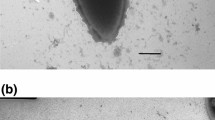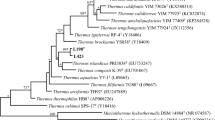Abstract
A novel coccoid-shaped, hyperthermophilic, heterotrophic member of the archaea was isolated from a shallow marine hydrothermal system at Vulcano Island, Italy. The isolate grew between 56 and 90°C with an optimum around 85°C. The pH range for growth was 6.5 to 10.5, with an optimum around 9.0. Polysulfide and elemental sulfur were reduced to H2S. Sulfur stimulated the growth rate. The isolate fermented yeast extract, peptone, meat extract, tryptone, and casein. Isovalerate, isobutyrate, propionate, acetate, CO2, NH3, and H2S (in the presence of So) were detected as end products. Growth was not inhibited by H2. Based on DNA-DNA hybridization and 16S rRNA partial sequences, the new isolate represents a new species ofThermococcus, which we namedThermococcus alcaliphilus. The type strain is isolate AEDII12 (DSM 10322)
Similar content being viewed by others
References
Balch WE, Wolfe RS (1976) New approach to the cultivation of methanogenic bacteria: 2-mercaptoethanesulfonic acid (HS-CoM)-dependent growth ofMethanobacterium ruminantium in a pressurized atmosphere. Appl Environ Microbiol 32:781–791
Baumeister W, Lembeke G (1992) Structural features of archaebacterial cell envelopes. J Bioenerg Biomembr 24:567–575
Blumentals II, Itoh M, Olson GJ, Kelly RM (1990) Role of polysulfides in reduction of elemental sulfur by the hyperthermophilic archaebacteriumPyrococcus furiosus. Appl Environ Microbiol 56:1255–1262
Brenner DJ (1973) Desoxyribonucleic acid reassociation in the taxonomy of enteric bacteria. Int J Syst Bacteriol 22:298–307
Brosius J, Palmer JL, Kennedy JP, Noller HF (1978) Complete nucleotide sequence of a 16S ribosomal RNA gene fromEscherichia coli. Proc Natl Acad Sci USA 75:4801–4805
De Rosa M, Gambacorta A (1988) The lipids of archaebacteria. Prog Lipid Res 27:153–175
Fauque G, Le Gall J, Barton LL (1991) Sulfate-reducing and sulfur-reducing bacteria. In: Shively JM, Barton LL (eds) Variations in autotrophic life. Academic Press, London, pp 271–337
Fiala G, Stetter KO (1986)Pyrococcus furiosus sp. nov. represents a novel genus of marine heterotrophic archaebacteria growing optimally at 100°C. Arch Microbiol 145:56–61
Fonselius SH (1983) Determination of hydrogen sulfide. In: Grasshoff K, Erhardt M, Kremling K (eds) Sea water analysis. Verlag Chemie, Weinheim, pp 73–80
Giggenbach W (1972) Optical spectra and equilibrium distribution of polysulfide ions in aqueous solution at 20°C. Inorg Chem 11:1201–1207
Hafenbradl D, Keller M, Thiericke R, Stetter KO (1993) A novel unsaturated archaeal ether core lipid from the hyperthermophileMethanopyrus kandleri. System Appl Microbiol 16: 165–169
Huber R, Langworthy TA, König H, Thomm M, Woese CR, Sleytr UB, Stetter KO (1986)Thermotoga maritima sp. nov. represents a new genus of unique extremely thermophilic eubacteria growing up to 90°C. Arch Microbiol 144:324–333
Ikeda S, Satake H, Hisona T, Terazawa T (1972) Potentiometric argimetric method for the successive titration of sulphide and dissolved sulphur in polysulphide solutions. Talanta 17:1650–1654
Kates M (1995) Techniques of lipidology: isolation, analysis and identification of lipids. In: Burden RH, Van Knippenberg PH (eds) Laboratory techniques in biochemistry and molecular biology. Elsevier, New York, pp 437–438
Klimmek O, Krüger A, Streudel R, Holdt G (1991) Growth ofWolinella succinogenes with polysulfide as terminal acceptor of phosphorylative electron transport. Arch Microbiol 155: 177–182
Kobayaschi T, Kwak YS, Akiba T, Kudo T, Horikoshi K (1994)Thermococcus profundus sp. nov., a new hyperthermophilic archaeon isolated from a deep-sea hydrothermal vent. Syst Appl Microbiol 17:232–236
Larsen N, Olsen GJ, Maidak BL, McCaughey MJ, Overbeck R, Macke TJ, Marsh TL, Woese CR (1993) The ribosomal data-base project. Nucleic Acids Res 21:3021–3023
Lauerer G, Kristjansson JK, Langworthy TA, König H, Stetter KO (1986)Methanothermus sociabilis sp. nov., a second species within the Methanothermaceae growing at 97°C. Syst Appl Microbiol 8:100–105
Marmur J, Doty P (1962) Determination of the base composition of desoxyribonucleic acid from its thermal denaturation temperature. J Mol Biol 5:109–118
Meyer SA, Schleifer KH (1978) Desoxyribonucleic acid reassociation in the classification of coagulase-positive Staphylococci. Arch Microbiol 117:183–188
Miroshnichenko ML, Bonch-Osmolovskaya EA, Neuner A, Kostrikina NA, Chernych NA, Alekseev VA (1989)Thermococcus stetteri sp. nov., a new extremely thermophilic marine sulfur-metabolizing archaebacterium. Syst Appl Microbiol 12:257–262
Neuner A, Jannasch HW, Belkin S, Stetter KO (1990)Thermococcus litoralis sp. nov.: a new species of extremely thermophilic marine archaebacteria. Arch Microbiol 153:205–207
Nishihara M, Koga Y (1987) Extraction and composition of polar lipids from the archaebacterium,Methanobacterium thermoautotrophicum: effective extraction of tetraether lipids by an acidified solvent. J Biochem 101:997–1005
Saiki RK, Gelfand DH, Stoffel S, Scharf SJ, Higuchi R, Horn GT, Mullis KB, Erlich HA (1988) Primer-directed enzymatic amplification of DNA with a thermostable DNA polymerase. Science 239:487–491
Schauder R, Kröger A (1993) Bacterial sulfur respiration. Arch. Microbiol 159:491–497
Stetter KO (1992) Life at the upper temperature border. In: Tran Than Van J, Tran Than Van K, Mounolou JC, Schneider J, McKay C (eds) Frontiers of life. Editions Frontières, Gif-sur-Yvette, pp 195–219
Stetter KO, König H, Stackebrandt E (1983)Pyrodictium gen. nov., a new genus of submarine disc-shaped sulphur-reducing archaebacteria growing optimally at 105°C. Syst Appl Microbiol 4:535–551
Völkl P, Huber R, Drobner E, Rachel R, Burggraf S, Trincone A, Stetter KO (1993)Pyrobaculum aerophilum sp. nov., a novel nitrate-reducing hyperthermophilic archaeum. Appl Environ Microbiol 59:2918–2926
Welsh J, McClelland M (1990) Fingerprinting genomes using PCR with arbitrary primers. Nucleic Acids Res 18:7213–7218
Woese CR, Kandler O, Wheelis ML (1990) Towards a natural system of organisms: proposal for the domains archaea, bacteria and eukarya. Proc Natl Acad Sci USA 87:4576–4579
Zillig W, Holz I, Janekovic D, Schäfer W, Reiter WD (1983) The archaebacteriumThermococcus celer represents a novel genus within the thermophilic branch of the archaebacteria. Syst Appl Microbiol 4:88–94
Zöphel A, Kennedy MC, Beinert ZH, Kroneck PMH (1988) Investigations on microbial sulfur respiration. 1. Activation and reduction of elemental sulfur in several strains of eubacteria. Arch Microbiol 150:72–77
Author information
Authors and Affiliations
Corresponding author
Rights and permissions
About this article
Cite this article
Keller, M., Braun, FJ., Dirmeier, R. et al. Thermococcus alcaliphilus sp. nov., a new hyperthermophilic archaeum growing on polysulfide at alkaline pH. Arch. Microbiol. 164, 390–395 (1995). https://doi.org/10.1007/BF02529736
Received:
Accepted:
Issue Date:
DOI: https://doi.org/10.1007/BF02529736




